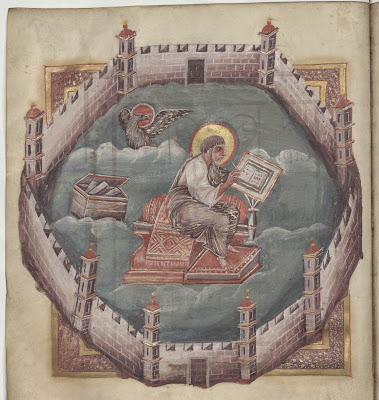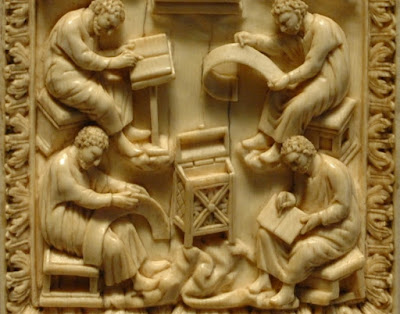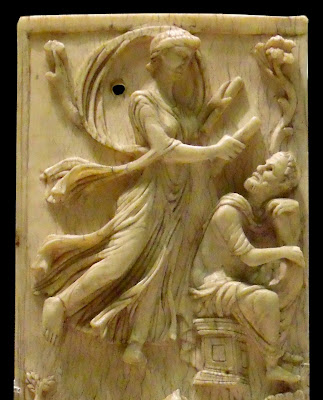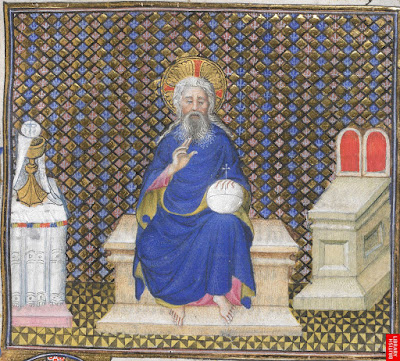 |
| David composing the psalms. (detail of fol 1v) In this illustration we see a plinth chair, a foot stool, and a desk. both the chair and the desk are depicted as paneled furniture |
Most people assume these plinth chairs to be chests; if a "chest" is completely synonymous to an enclosed square or rectangular box form, then perhaps they are chest. I strongly disagree with this narrow classification, however, as there are numerous medieval illustrations showing both chests and 'plinth chairs' in the same scene, with a distinctly different form, and manner of decoration. They are, in my opinion, no more "chests" than an "ottoman" (known also as a tuffet or hassock) is a chest, which is incidentally a modern version of the former. Modern refrigerators are basically of 'cabinet' form, yet one never sees them classified as such in furniture books. I introduced this form of seating by the name of "Plinth Chair" a couple years ago here, so there is no need to repeat myself completely.
 |
| St John from a 9th century gospel book, Rheims Bibliothèque de l'Arsenal MS 1171 fol 164v In this illustration one clearly seas the difference between the chest and the chair. |
In the Utrecht Psalter, there are at least 21 illustrations depicting no less than 25 separate chairs of this type. There is no need to show multiple illustrations of them here, because, in keeping with the general impressionistic nature of the illustrations in this work, they are all of near identical design, showing only the basic form. A few have, as the above illustration shows, the addition of the indication of paneled construction by way of a secondary rectangle drawn within the perimeter of the main body.
Unfortunately, no chair like this has survived from any time in the medieval period, which leaves most people, without a second thought, to assume the objects in these illustrations to be chests. As can be seen in the above illustration, though, this particular design would be very impractical as a chest in the sense that we usually think of them, for reasons such as the very pronounced overhang of the top and the large protruding moulded base. Many of these chairs are also depicted, as the above example, with curved or shaped sides. This is not to say that they could not have been used for storage, no example that I have found in artwork is detailed enough to prove or disprove this concept. In fact, there is no reason to doubt that some would have been used as such. Others, however, are depicted with open arcading or in other forms of semi-openness which indicates that even if some examples might have doubled as storage items, they were not all used as such, nor was that their primary function. Simply put, they are a distinct form of seating, made and used as such.
 |
| 9th century ivory panel, formerly part of a book cover, now in the Louvre |
The above ivory panel detail is great for two reasons, the first is that it shows four such chairs in various states from completely enclosed (top left) to completely open, having only a base, and seat connected by four legs. (lower left) The top right could either be paneled or having openings, and the lower right depicts a plinth chair with solid ends, but open sides. (part of the ivory has chipped off of this one) The second reason I like this carving is because of the chest in the centre which completely flies in the face of most people's concept of early medieval furniture. This is more of a 'cabinet' in size and shape, has a vault shaped lid, and carved post and panel constructed sides.
The idea that early furniture, including these plinth chairs, was necessarily "crude" or "primitive" is further dispelled by two more illustration, this time from a later 10th century manuscript now located in Strahov Monastery in Prague, but originating from Trier, Germany. I have cropped the pictures to allow the details to be readily visible. The artist (known as "Meister des Registrars Gregorium") has indicated mitred corners to the panels in the body of the chair, gold accent to the moulding, and a carved acanthus leaf panel in the second example which is all in gold leaf with painted moulding. Some of the gold leaf has been lost on the left edge, revealing the very carefully drawn details of the chair.
 |
| Two details from a Trier Gospel book, now housed in the Strahov Monastary ca 980 |
These chairs are illustrated in every century of the Middle Ages, from the 6th (the beginning of the "medieval" period)...
 |
| 6th century panel from Rome, still very much in the "antique" style of the Roman era. This chair is exactly the same as the two 10th century examples. |
...to the 15th, which is the end of the Middle Ages. In fact, I have one example that I stumbled across from the middle of the 16th century, but cannot remember where I filed it.
 |
| From the British Library comes this early 15th century example BL Yates Thompson MS 37 fol 103r |
This is an excellent illustration because it shows that just as in the 9th century, the artist made no real distinction between the altar (shown with two red tablets representing a diptych) and the chair. As I have mentioned many times before, the artists were usually not very concerned with details in book illustrations. In the Utrecht Psalter, the plinth chairs and altars have exactly the same form and only other associated items distinguish one (unoccupied) type of furniture from the other, just as the diptych does here.
As I have said, no such chair survives, so any attempt at reconstructing one would be purely speculative. Some clues to the type of ornament used, however, might come from carved stone panels of the same time period in question, such as this 10th century former altar frontal, shown below.
 |
| This carved stone altar panel might give some indication of what a moulded wooden panel might have looked like. |
I have no idea when these chairs first came into vogue, but throughout the course of the Middle Ages they remained extremely popular and survived well into our modern era. As times and tastes have changed, they have adapted to those changes in material and the application of ornament and finish, but their basic form held true for more than a thousand years. To me it is a great wonder that no one else has ever given them as much as a second thought or the place they deserve in books of furniture history.
Videre Scire


No comments:
Post a Comment